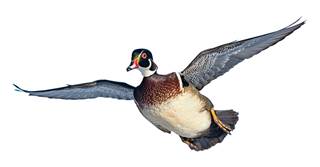Wood Duck Shooting
Connecting with these colorful aerial acrobats is one of wingshooting's toughest challenges
Connecting with these colorful aerial acrobats is one of wingshooting's toughest challenges
Wood ducks are the waterfowler's equivalent of ruffed grouse, possessing the ability to twist and dodge among branches at top speed. Whereas a grouse weaves through brush at 20 miles per hour, a wood duck flies through the trees at 30, often in low light. Shooting techniques specific to this kind of hunting are worth mastering, because the prize is one of our prettiest and tastiest ducks.
While wood ducks sometimes come to decoys, hunting them usually involves pass shooting along a flight line at dawn or dusk. Success begins with being in the right place. You can't hit what you can't see, so put yourself where you will get a good view of birds against the open sky and not against a jumble of branches, where they will disappear. During the first and last few minutes of shooting time you have an advantageducks looking down can't see you as well as you can see them silhouetted against the sky.
Shot selection matters. Wood ducks often come all at once, and if you're in a good spot you may see a hundred or more in a few minutes. Be picky. Shooting at every bird in range only increases the chances that your gun will be empty or you'll be looking the wrong way when a good shot presents itself.
If ever there was a situation that favored an instinctive shooting technique, it's wood duck hunting. Your shots will come at birds zipping by overhead, dodging through branches, or flipping back and forth as they come to roost. A shooting style based on the Churchill method (in which a shooter mounts and swings the shotgun with a single motion) combined with a steady focus on the target will serve you best. Essentially, it's a swing-through technique that starts with an unmounted gun and concludes just as the butt comes to your shoulder and the barrel passes the bird. This gives you a better view of the bird than you'll get chasing it with a mounted gun, and it allows your eyes and hands to make last-minute corrections at a swerving, erratic target.
In the half-light of early morning or late afternoon, everything appears farther away and faster than it really is. In reality, most shots at wood ducks are at close range if you're set up right. A 12- or 20-gauge loaded with steel 4 shot and an improved cylinder or light-modified choke is all the gun you need. Test your gun at 20 and 25 yards to be sure your pattern is wide enough at close range.
Some hunters prefer fiber-optic beads in low light. They are valuable as long as you treat them as a visual aid rather than a sight. The bead is there to help you locate the barrel in your peripheral vision. If you let a bright bead pull your eye off the target, it becomes more of a hindrance than a help.
As for practice, skeet presents almost every shot you'll see in a wood duck swamp, including crossers and incomers. The high house at station one simulates a wood duck that flies over your head from behind. Some sporting clays stations feature curling and dropping chandelle and battue targets that will tune you up for some of the more extreme wood duck maneuvers.
You can also practice fast reloads to keep from getting caught with an empty gun when wood ducks are pouring in. One accessory that can help with this is a stock-mounted shell holder. If you put the shells in with the brass end down, you can pluck them out and load them quickly. Spend some time familiarizing yourself with this technique, because the minutes you get to shoot at wood ducks are too fleeting to spend any of them with an unloaded gun.

Photo THERAWSPIRIT.COM
Jump-shooting, by sneaking ponds or walking or floating creeks and rivers, is the best way to hunt wood ducks in between morning and evening flights. Almost all the shots will be at birds going away, and some shots will be slightly longer. Tighten your choke to modified, and shoot one or two shot sizes larger to compensate. The going-away angles of trap are good practice. If you hunt from a canoe, practice shooting clays while sitting in a chair.
Ducks Unlimited uses cookies to enhance your browsing experience, optimize site functionality, analyze traffic, and deliver personalized advertising through third parties. By continuing to use this site, you agree to our use of cookies. View Privacy Policy